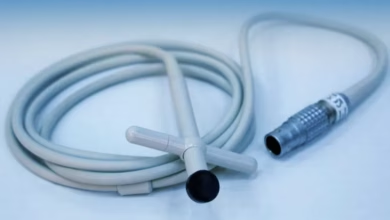What Is a Phased Array Transducer?
Medical imaging relies on different types of transducers, each carefully designed to optimize visualization of particular regions of the body. For example, linear probes are commonly used for superficial structures, while convex probes are preferred for abdominal and obstetric imaging.
In the same way, phased array probes were specifically developed to meet the unique challenges of cardiac imaging. Because the heart lies deep within the chest and is surrounded by ribs and lungs, a transducer with a small footprint and advanced beam-steering capability is essential.
In this article, we will take a closer look at the phased array probe, exploring how it works, its applications, and more.
An Introduction to Phased Array Transducers
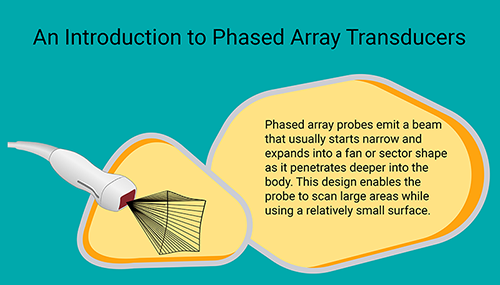
A phased array transducer, one of the most commonly used types of ultrasound transducers, gets its name from the specific arrangement of piezoelectric crystals known as a phased array. Phased array probes are designed to both emit and receive sound waves. They consist of multiple crystals (typically between 16 and 128), each capable of operating independently at frequencies ranging from 2 to 7.5 MHz. Phased array probes emit a beam that usually starts narrow and expands into a fan or sector shape as it penetrates deeper into the body. This design enables the probe to scan large areas using a relatively small surface.
How Does a Phased Array Transducer Work?

As discussed earlier, all ultrasound transducers transmit sound waves into the body and receive echoes to create diagnostic images. Phased array ultrasound is beneficial in various applications, such as cardiac imaging.
For example, a phased array transducer is placed on the patient’s chest, and its multiple piezoelectric elements electronically steer the ultrasound beams in different directions without physically moving the probe. Then, these beams reflect off the heart tissues, and the echoes are captured to produce real-time, high-resolution images. The system dynamically adjusts the focus of the beams for optimal clarity, especially for critical structures like heart valves. This enables doctors to assess blood flow and diagnose heart abnormalities without the need for invasive procedures.
What Are the Benefits of Phased Array Probes?
Phased array transducers are built with advanced technology to provide clear, real-time images and versatile diagnostic options. As a result, these features help doctors work more accurately and efficiently. Here are the key benefits:
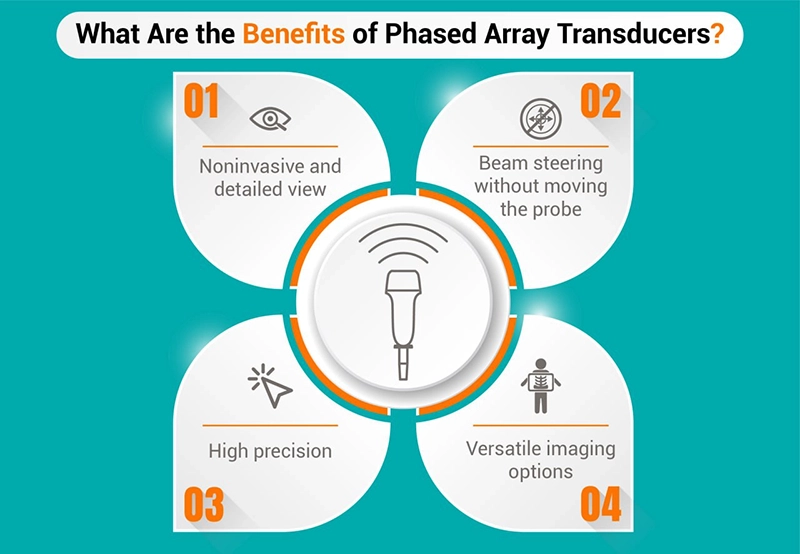
Noninvasive and detailed view
One key feature of phased array transducers is their non-invasive nature. They provide a detailed, real-time view of different body tissues from various angles without the need for invasive procedures.
Beam steering without moving the probe
Another key feature that makes phased array probes unique is their ability to electronically steer the ultrasound beams, which makes it easier to image various parts of the heart from a single position.
High precision
By electronically adjusting focus, phased array probes improve image resolution to provide a clearer view of specific areas.
Versatile imaging options
Besides structural imaging, phased array probes can assess blood flow using Doppler imaging, providing a complete picture of the heart’s functionality.
Phased Array Transducers Applications
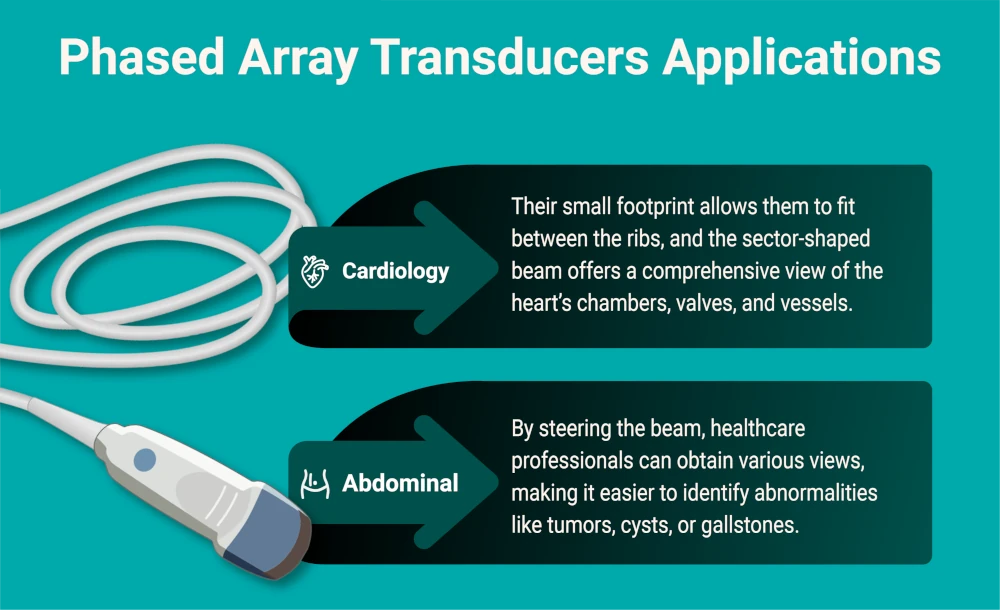
Like other ultrasound transducers, phased array probes serve multiple purposes. Their flexibility makes them valuable across a wide range of medical imaging applications. These range from cardiology to abdominal studies and extend well beyond. We will discuss them in more detail below:
Cardiology
Phased array probes are widely used in cardiac examinations to produce detailed, real-time images of the heart. Their small footprint allows them to fit between the ribs, and the sector-shaped beam offers a comprehensive view of the heart’s chambers, valves, and vessels.
Abdominal Imaging
Phased array probes are also used for abdominal imaging, including the liver, gallbladder, kidneys, and pancreas. By steering the beam, healthcare professionals can obtain various views, making it easier to identify abnormalities like tumors, cysts, or gallstones.
Phased Array Transducers Vs. Convex Transducers
Phased array and convex transducers are two commonly used tools in medical imaging, each offering unique advantages depending on their application. To better understand the best type for our needs, below is a comprehensive comparison highlighting their key differences in design, functionality, and typical uses.
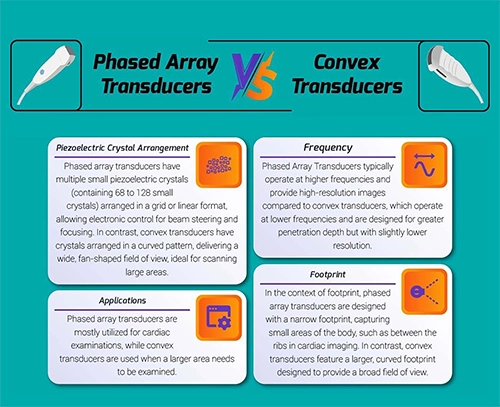
1- Piezoelectric Crystal Arrangement
Phased array transducers have multiple small piezoelectric crystals (containing 68 to 128 small crystals) arranged in a grid or linear format. This allows electronic control for beam steering and focusing. In contrast, convex transducers have crystals arranged in a curved pattern, delivering a wide, fan-shaped field of view, ideal for scanning large areas.
2- Frequency
Phased Array Transducers typically operate at higher frequencies and provide high-resolution images compared to convex transducers, which operate at lower frequencies and are designed for greater penetration depth but with slightly lower resolution.
3- Footprint
In the context of footprint, phased array transducers are designed with a narrow footprint. This unique design allows them to capture small areas of the body, such as between the ribs, in cardiac imaging. In contrast, convex transducers feature a larger, curved footprint designed to provide a broad field of view.
4- Applications
Phased array transducers are mostly utilized for cardiac examinations. On the other hand, convex transducers are used when a larger area needs to be examined.
Top Phased Array Transducers Brands for Medical Imaging
Here are some of the most well-known and top brands of phased array transducers used in medical imaging:
- GE: Some popular GE brands are GE 3SC-RS and GE M5Sc-D.
- Fujifilm SonoSite: Some popular Fujifilm SonoSite brands are Fujifilm SonoSite P21xp and Fujifilm SonoSite RP19xp.
- Philips: Some popular Philips brands are Philips S4-2 and Philips S5-1.
- Siemens: Some popular Siemens brands are Siemens 4V1 and Siemens 4Z1C.
- Canon: Some popular Canon brands are PST-30BT and 12S4.
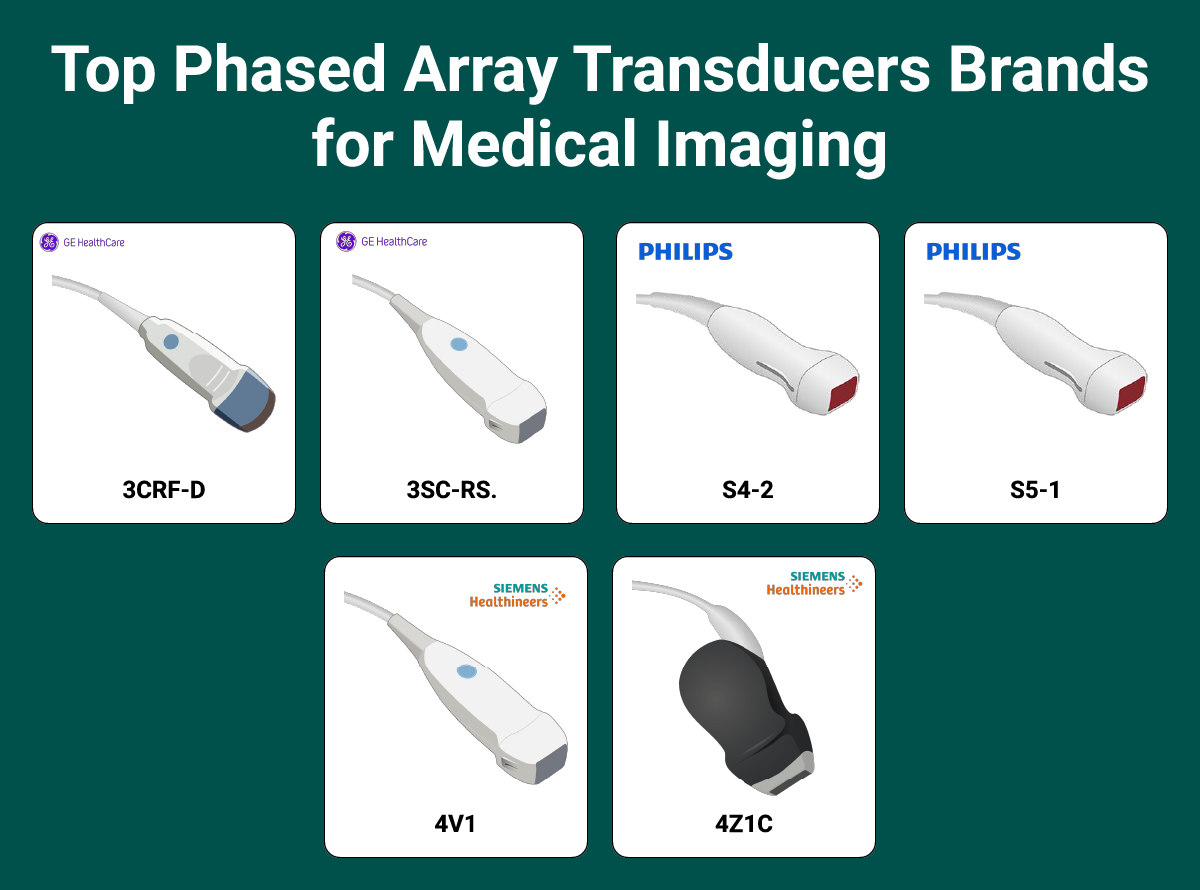
Refurbished Phased Array Probes: Smart & Cost-Effective
So far, we’ve highlighted the top brands of phased array probes along with their most popular models. These probes are available on the market in brand-new, used, and refurbished conditions. Among these options, refurbished probes stand out because they not only provide optimal functionality but are also considered highly cost-effective.
For clinicians, healthcare providers, and other professionals who use these devices, this balance of performance and affordability makes refurbished probes a practical choice. To meet this demand, Elzhen offers and provides a wide range of refurbished probes, including the models mentioned earlier, through its online platform.
Conclusion: Reliable and Affordable Phased Array Probes
Phased array probes are specialized ultrasound transducers designed for detailed imaging of the heart, abdomen, and other critical areas. Because of their importance, many clinicians look for ways to balance performance with cost, and refurbished probes often provide that ideal solution.
At Elzhen, we not only offer a wide range of refurbished phased array probes but also provide professional probe repair services, ensuring that healthcare providers can maintain reliable equipment without unnecessary expense. This combination of quality, affordability, and ongoing support makes Elzhen a trusted source for medical imaging solutions.



